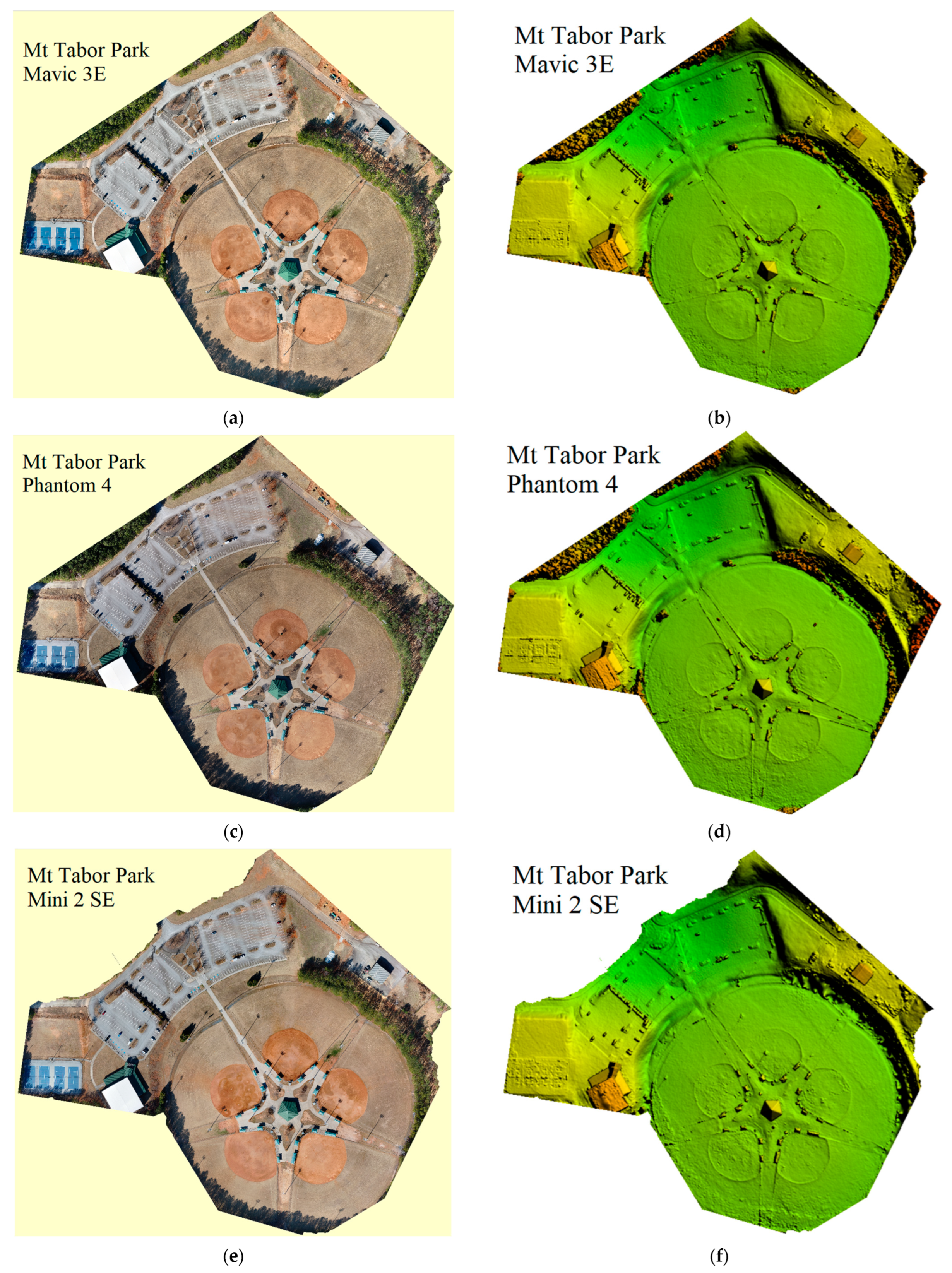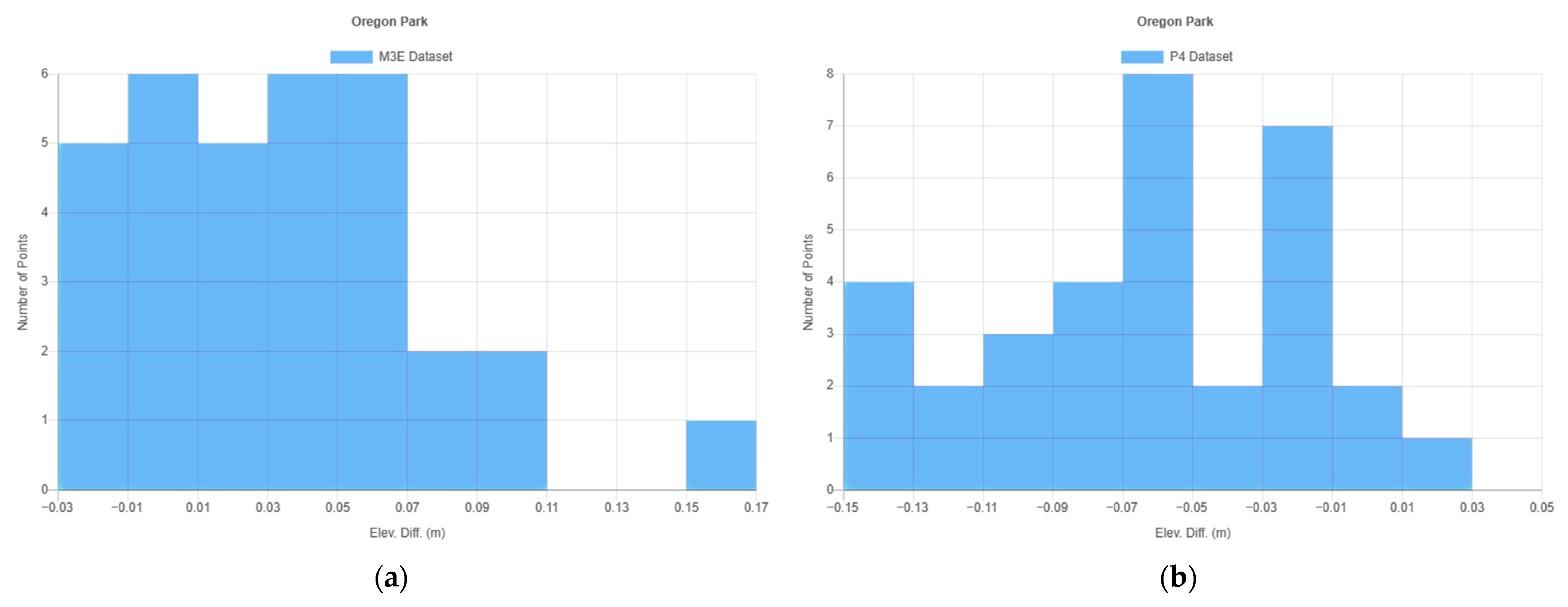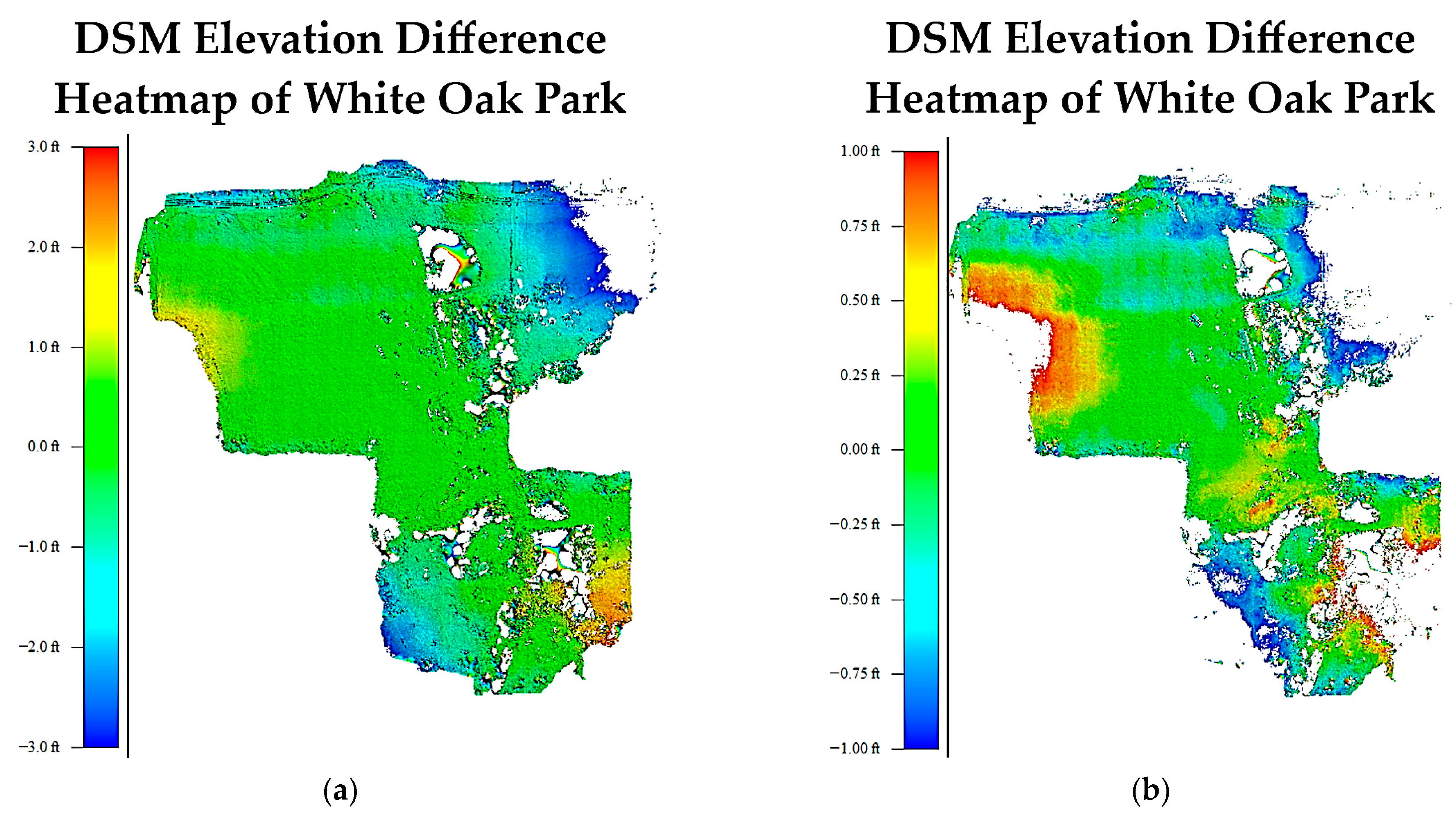Studying the Difference Between Mapping Accuracy of Non-RTK Ultra-Lightweight and RTK-Enabled Survey-Grade Drones
Abstract
1. Introduction
2. Literature Review
3. Datasets and Methodology
4. Results and Discussion
- Orthomosaics were inspected in terms of coverage and clarity.
- Generated DSMs were compared to each other and to the ground points observed with a GNSS receiver. Then, descriptive statistics and analysis of variance (ANOVA) were applied to the elevation differences for further analysis.
4.1. Results of Oregon Park
4.2. Results of Mt. Tabor Park
4.3. Results of White Oak Park
4.4. Quality Control of the Generated DSMs
4.4.1. Quality Control of Oregon Park’s DSM
4.4.2. Quality Control of Mt. Tabor Park’s DSM
4.4.3. Quality Control of White Oak Park’s DSM
- Increasing the number of GCPs;
- Changing flight parameters, such as increasing the front and side overlap of images or reducing the flight altitude;
- Flying in grid pattern, rather than single flight lines;
- Dividing the site into smaller parts and flying and processing each part separately;
- Using a LiDAR sensor instead of a camera for densely vegetated areas;
- Employing photogrammetric algorithms optimized for non-RTK drones;
- Mounting an external RTK module on the ultralight drone.
5. Conclusions
- Weather conditions, especially wind (up to 13 km/h);
- Area size (up to 11 hectares);
- Number and distribution of GCPs.
- Wind speed is a natural phenomenon and obviously cannot be controlled. Therefore, an exact number for the wind speed threshold cannot be determined. The wind speed mentioned in the bullet points in the above paragraph was the fastest wind speed tested that produced reliably precise results. Furthermore, data regarding wind speed is normally available as an average number in a given area for each hour of the day. Even if one tries to use a separate instrument to record wind speed at a higher frequency in real-time during the flight, it will not be the same wind speed that the drone experiences since the operator would be measuring the wind speed at a fixed location on the ground while the drone is experiencing a different wind speed at an altitude of 100 m above ground. That said, the hourly average wind speed provides a sufficient measure of wind speed impact on the drones’ mapping accuracy.
- Flight sites were selected to have different sizes, which were 8, 11, and 34 hectares. The ultra-lightweight drone produced survey-grade results for the 11-hectare site and generated less precise results for the 34-hectare site. However, it would not be practical to increase the area size incrementally to reach an exact threshold, and it was not the intent of this work either. The goal of this study was to test whether ultralight drones can produce survey-grade results for small sites or not. Considering that many other factors affect the final mapping accuracy, determining a precise number as the area size threshold would not be correct either. Additionally, the area size of the majority of small projects (in urban areas, industrial sites, etc.) is smaller than 11 hectares, suggesting that an ultra-lightweight drone can potentially be employed for such projects. However, when high-precision results are required for larger sites (over 11 hectares), using a commercial survey-grade drone is recommended.
- The number of observed GCPs was kept almost the same (10–12 GCPs) for all three sites intentionally to test the ultralight drone’s performance. In White Oak Park, which was the largest site (34 hectares), the mapping accuracy of Mini2 could potentially improve with more GCPs, but as mentioned earlier, in this study, some determining factors such as GCPs were kept the same so that the performance of these three drones could be compared more accurately.
- It is worth mentioning that while the type of UAVs certainly affects their performance and accuracy, the results obtained in this work indicate the inherent susceptibility of ultra-lightweight drones to wind and the fact that their accuracy degenerates with the area size since they are non-RTK drones. That is, all types of ultra-lightweight drones would struggle to resist strong winds due to their light weight, and they would deviate from the planned flight lines, which consequently decreases the side overlaps and adversely affects mapping accuracy. Moreover, such ultralight drones do not have RTK capability, so their mapping error accumulates with time. Therefore, the larger the flight site, the longer the flight time would be, which decreases mapping accuracy as well.
- This study was aimed at investigating the mapping accuracy of non-RTK ultralight drones in comparison with RTK-enabled drones using exactly the same flight and data processing parameters. Considering the results obtained in this work and the discussions provided, the seven potential solutions listed at the end of Section 4.4.3 can be explored as follow-up to this work to inspect their impact on the mapping results of non-RTK ultralight drones.
Supplementary Materials
Funding
Data Availability Statement
Acknowledgments
Conflicts of Interest
Abbreviations
| UA | Unmanned Aircraft |
| 3D | Three-Dimensional |
| GNSS | Global Navigation Satellite System |
| RGB | Red, Green, Blue |
| LiDAR | Light Detection and Ranging |
| DSM | Digital Surface Model |
| DTM | Digital Terrain Model |
| FAA | Federal Aviation Administration |
| kg | Kilo Gram |
| CFR | Code of Federal Regulations |
| RTK | Real-Time Kinematic |
| UAV | Unmanned Aerial Vehicle |
| MP | Mega Pixel |
| GCP | Ground Control Points |
| QC | Quality Control |
| ANOVA | Analysis of Variance |
| SfM | Structure-from-Motion |
| GIS | Geographic Information System |
| DEM | Digital Elevation Model |
| NAD 83 | North American Datum 1983 |
| NAVD 88 | North American Vertical Datum 1988 |
| SI | System International |
| LAE | Low-Altitude Economy |
References
- Yang, B.; Fang, L. Automated extraction of 3-D railway tracks from mobile laser scanning point clouds. IEEE J. Sel. Top. Appl. Earth Obs. Remote Sens. 2014, 7, 4750–4761. [Google Scholar] [CrossRef]
- Arastounia, M. Automated recognition of railroad infrastructure in rural areas from LiDAR data. Remote Sens. 2015, 7, 14916–14938. [Google Scholar] [CrossRef]
- Dorninger, P.; Pfeifer, N. A comprehensive automated 3D approach for building extraction, reconstruction, and regularization from airborne laser scanning point clouds. Sensors 2008, 8, 7323–7343. [Google Scholar] [CrossRef]
- Federal Aviation Administration. Remote Pilot—Small Unmanned Aircraft Systems Study Guide. Available online: https://www.faa.gov/sites/faa.gov/files/regulations_policies/handbooks_manuals/aviation/remote_pilot_study_guide.pdf (accessed on 10 April 2025).
- Shahmoradi, J.; Talebi, E.; Roghanchi, P.; Hassanalian, M. A Comprehensive Review of Applications of Drone Technology in the Mining Industry. Drones 2020, 4, 34. [Google Scholar] [CrossRef]
- Nirmal, S.; Kumbhar, V. Applications of drone and unmanned aerial vehicle (UAV) surveying for planning for cities. Int. J. Res. Appl. Sci. Eng. Technol. 2024, 12, 885–888. [Google Scholar] [CrossRef]
- Bui, X.; Lee, C.; Long, N.; Ahmed, A.; Cao, X.; Nghia, N.; Canh, L.; Nguyen, H.; Le, Q.; Huong, D.; et al. Use of unmanned aerial vehicles for 3D topographic mapping and monitoring the air quality of open-pit mines. Inżynieria Miner. POL-VIET Test 2022, 2, 223–239. [Google Scholar] [CrossRef]
- Long, N.; Dang, M.; Bui, L.; Bui, Q.; Tran, T.X. Application of unmanned aerial vehicles for surveying and mapping in mines: A review. In Advances in Geospatial Technology in Mining and Earth Sciences; Springer: Cham, Switzerland, 2023. [Google Scholar] [CrossRef]
- Hugenholtz, C.; Brown, O.; Walker, J.; Barchyn, T.E.; Nesbit, P.; Kucharczyk, M.; Myshak, S. Spatial Accuracy of UAV-Derived Orthoimagery and Topography: Comparing Photogrammetric Models Processed with Direct Geo-Referencing and Ground Control Points. Geomatica 2016, 70, 21–30. [Google Scholar] [CrossRef]
- Martínez-Carricondo, P.; Agüera-Vega, F.; Carvajal-Ramírez, F.; Mesas-Carrascosa, F.J.; García-Ferrer, A.; Pérez-Porras, F.J. Assessment of UAV-photogrammetric mapping accuracy based on variation of ground control points. Int. J. Appl. Earth Obs. Geoinf. 2018, 72, 1–10. [Google Scholar] [CrossRef]
- Allison, M.; Adcock, S. Drone surveying in a complex area: A case study. In Proceedings of the SEG International Exposition and Annual Meeting, San Antonio, TX, USA, 15 September 2019; pp. 279–282. [Google Scholar] [CrossRef]
- Long, N.; Goyal, R.; Bui, L.; Cao, C.; Canh, L.; Minh, N.; Bui, X. Optimal choice of the number of ground control points for developing precise DSM using light-weight UAV in small and medium-sized open-pit mine. Arch. Min. Sci. 2021, 66, 369–384. [Google Scholar] [CrossRef]
- Lee, J.; Jo, H.; Oh, J. Application of Drone LiDAR Survey for Evaluation of a Long-term Consolidation Settlement of Large Land Reclamation. Appl. Sci. 2023, 13, 8277. [Google Scholar] [CrossRef]
- Kundu, S.; Das, N.; Saha, D.; Biswas, P. Unknown terrain imaging with adaptive spatial resolution using UAV. Ad Hoc Netw. 2022, 135, 102937. [Google Scholar] [CrossRef]
- Zhou, Y. Unmanned aerial vehicles based low-altitude economy with lifecycle techno-economic-environmental analysis for sustainable and smart cities. J. Clean. Prod. 2025, 499, 145050. [Google Scholar] [CrossRef]
- Rachmawati, S.; Putra, A.; Priyatama, A.; Parulian, D.; Katarina, D.; Habibie, M.; Siahaan, M.; Ningrum, E.; Medikano, A.; Valentino, V.H. Application of Drone Technology for Mapping and Monitoring of Corn Agricultural Land. In Proceedings of the International Conference on ICT for Smart Society (ICISS), Bandung, Indonesia, 2–4 August 2021; pp. 1–5. [Google Scholar] [CrossRef]
- Oh, J.; Jang, Y.; Lee, C. Accuracy Analysis of Low-Cost UAV Photogrammetry for Corridor Mapping. J. Korean Soc. Surv. Geod. Photogramm. Cartogr. 2018, 36, 565–572. [Google Scholar] [CrossRef]
- Deliry, S.I.; Avdan, U. Accuracy assessment of UAS photogrammetry and structure from motion in surveying and mapping. Int. J. Eng. Geosci. 2024, 9, 165–190. [Google Scholar] [CrossRef]
- Nex, F.; Remondino, F. UAV for 3D mapping applications: A review. Appl. Geomat. 2013, 6, 1–15. [Google Scholar] [CrossRef]
- Shakhatreh, H.; Sawalmeh, A.; Al-Fuqaha, A.; Dou, Z. Unmanned Aerial Vehicles (UAVs): A Survey on Civil Applications and Key Research Challenges. IEEE Access 2019, 7, 48572–48634. [Google Scholar] [CrossRef]
- Lee, S.B.; Jeong, M.; Auh, S.C.; Kim, J.J. Development of standard work type to utilize drone at expressway construction sites. KSCE J. Civ. Environ. Eng. Res. 2021, 41, 461–468. [Google Scholar] [CrossRef]
- Mandirola, M.; Casarotti, C.; Peloso, S.; Lanese, I.; Brunesi, E.; Senaldi, I. Use of UAS for damage inspection and assessment of bridge infrastructures. Int. J. Disaster Risk Reduct. 2022, 72, 102824. [Google Scholar] [CrossRef]
- Liang, M.; Delahaye, D. Drone fleet deployment strategy for large scale agriculture and forestry surveying. In Proceedings of the IEEE Intelligent Transportation Systems Conference (ITSC), Auckland, New Zealand, 27–30 October 2019; pp. 4495–4500. [Google Scholar] [CrossRef]
- Tomczyk, A.; Ewertowski, M.; Creamy, N.; Ancin-Murguzur, R.; Monz, C. The application of unmanned aerial vehicle (UAV) surveys and GIS to the analysis and monitoring of recreational trail conditions. Int. J. Appl. Earth Obs. Geoinf. 2023, 123, 103474. [Google Scholar] [CrossRef]
- Barry, P.; Coakley, R. Accuracy of UAV photogrammetry compared with network RTK GPS. ISPRS Int. Arch. Photogramm. Remote Sens. Spat. Inf. Sci. 2013, 2, 27–31. [Google Scholar] [CrossRef]
- Uysal, M.; Toprak, A.S.; Polat, N. DEM generation with UAV photogrammetry and accuracy analysis in Sahitler hill. Measurement 2015, 73, 539–543. [Google Scholar] [CrossRef]
- Izere, P.; Zhao, B.; Schnable, J.; Ge, Y.; Shi, Y. Positioning accuracy of RTK-GNSS-enabled drones and their performance in agricultural crop sensing. J. Am. Soc. Agric. Biol. Eng. 2025, 68, 559–571. [Google Scholar] [CrossRef]
- Madawalagama, S.; Munasinghe, N.; Dampegama, S.; Samarakoon, L. Low-cost aerial mapping with consumer-grade drones. In Proceedings of the 37th Asian Conference on Remote Sensing, Colombo, Sri Lanka, 17–21 October 2016. [Google Scholar]
- Jiménez-Jiménez, S.I.; Ojeda-Bustamante, W.; Marcial-Pablo, M.d.J.; Enciso, J. Digital terrain models generated with low-cost UAV photogrammetry: Methodology and accuracy. Int. J. Geo-Inf. 2021, 10, 285. [Google Scholar] [CrossRef]
- Torres-Sánchez, J.; López-Granados, F.; Borra-Serrano, I.; Pena, J.M. Assessing UAV-collected image overlap influence on computation time and digital surface model accuracy in olive orchards. Precis. Agric. 2017, 19, 115–133. [Google Scholar] [CrossRef]
- Nagendran, S.K.; Tung, W.Y.; Ismail, M.A.M. Accuracy assessment on low altitude UAV-borne photogrammetry outputs influenced by ground control point at different altitudes. IOP Conf. Ser. Earth Environ. Sci. 2018, 169, 012031. [Google Scholar] [CrossRef]
- Kalacska, M.; Lucanus, O.; Arroyo-Mora, J.P.; Laliberté, É.; Elmer, K.; Leblanc, G.; Groves, A. Accuracy of 3D landscape reconstruction without ground control points using different UAS platforms. Drones 2020, 4, 13. [Google Scholar] [CrossRef]











| Specifications | Drones | ||
|---|---|---|---|
| Mavic 3E RTK | Phantom 4 RTK | Mini 2 SE | |
| Camera resolution (MP) | 20 | 20 | 12 |
| Image sensor | 4/3″ CMOS | 1″ CMOS | 1/2.3″ CMOS |
| Weight (g) | 915 | 1391 | 246 |
| Maximum flight speed with no wind (m/s) | 21 | 16 | 16 |
| Maximum flight time with no wind (min) | 45 | 30 | 30 |
| Maximum wind tolerance (m/s) | 12 | 10 | 10.7 |
| RTK Capability | Yes | Yes | No |
| Characteristics and Met Condition | Mapping Sites | ||
|---|---|---|---|
| Oregon Park | Mt. Tabor Park | White Oak Park | |
| Location | Marietta, GA, USA | Dallas, GA, USA | Dallas, GA, USA |
| Area (hectares) | 7.85 | 11.09 | 34.07 |
| Perimeter (km) | 1.19 | 1.34 | 3.04 |
| Wind speed (km/h) | 21 | 11 | 13 |
| Gust | Yes | No | No |
| Temperature (°C) | 7 | 14 | 10 |
| Weather description | Few clouds, no rain, windy with strong gust | Clear sunny sky, mild wind, no strong gust | Scattered clouds, fairly windy, no strong gust |
| Number of GCPs | 10 | 11 | 12 |
| Checkpoint No. | 23 | 27 | 57 |
| Front/Side overlap (%) | 80/75 | 80/75 | 80/75 |
| Flight altitude (m) | 100 | 100 | 100 |
| Statistical Measures of Elevation Differences | Mavic 3E | Phantom 4 |
|---|---|---|
| Minimum (m) | −0.03 | −0.15 |
| Maximum (m) | 0.16 | 0.01 |
| Standard deviation (m) | 0.04 | 0.04 |
| Range (m) | 0.19 | 0.16 |
| Average (m) | 0.03 | −0.07 |
| Statistical Measures of Elevation Differences | Mavic 3E | Phantom 4 | Mini 2 SE |
|---|---|---|---|
| Minimum (m) | −0.02 | −0.04 | −0.08 |
| Maximum (m) | 0.08 | 0.06 | 0.08 |
| Standard deviation (m) | 0.02 | 0.02 | 0.04 |
| Range (m) | 0.10 | 0.10 | 0.17 |
| Average (m) | 0.04 | −0.01 | 0.02 |
| Statistical Measures of Elevation Differences | Mavic 3E | Phantom 4 | Mini 2 SE |
|---|---|---|---|
| Minimum (m) | −0.07 | −0.07 | −0.40 |
| Maximum (m) | 0.15 | 0.19 | 0.46 |
| Standard deviation (m) | 0.04 | 0.05 | 0.16 |
| Range (m) | 0.23 | 0.26 | 0.87 |
| Average (m) | 0.01 | 0.02 | −0.01 |
Disclaimer/Publisher’s Note: The statements, opinions and data contained in all publications are solely those of the individual author(s) and contributor(s) and not of MDPI and/or the editor(s). MDPI and/or the editor(s) disclaim responsibility for any injury to people or property resulting from any ideas, methods, instructions or products referred to in the content. |
© 2025 by the author. Licensee MDPI, Basel, Switzerland. This article is an open access article distributed under the terms and conditions of the Creative Commons Attribution (CC BY) license (https://creativecommons.org/licenses/by/4.0/).
Share and Cite
Arastounia, M. Studying the Difference Between Mapping Accuracy of Non-RTK Ultra-Lightweight and RTK-Enabled Survey-Grade Drones. Automation 2025, 6, 60. https://doi.org/10.3390/automation6040060
Arastounia M. Studying the Difference Between Mapping Accuracy of Non-RTK Ultra-Lightweight and RTK-Enabled Survey-Grade Drones. Automation. 2025; 6(4):60. https://doi.org/10.3390/automation6040060
Chicago/Turabian StyleArastounia, Mostafa. 2025. "Studying the Difference Between Mapping Accuracy of Non-RTK Ultra-Lightweight and RTK-Enabled Survey-Grade Drones" Automation 6, no. 4: 60. https://doi.org/10.3390/automation6040060
APA StyleArastounia, M. (2025). Studying the Difference Between Mapping Accuracy of Non-RTK Ultra-Lightweight and RTK-Enabled Survey-Grade Drones. Automation, 6(4), 60. https://doi.org/10.3390/automation6040060






